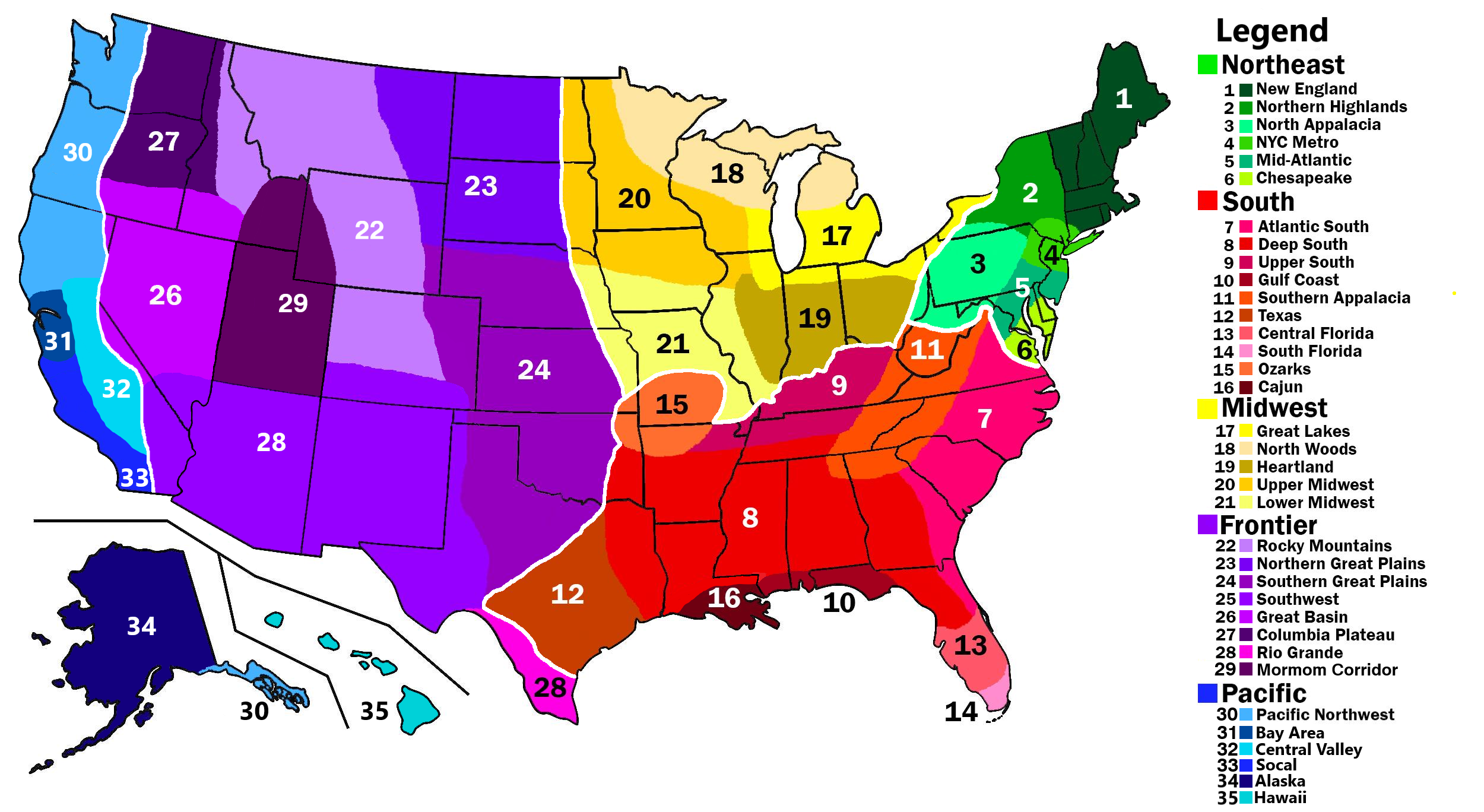US Cultural Regions Map


Marcus Rodriguez
Historical Geography Expert
Marcus Rodriguez specializes in historical cartography and geographic data analysis. With a background in both history and geography, he brings unique...
Geographic Analysis
What This Map Shows
The "US Cultural Regions Map" offers a comprehensive visualization of the various cultural regions across the United States. This map categorizes the entire country into distinct areas, each characterized by unique cultural attributes, traditions, and social behaviors. From the bustling urban centers of the Northeast to the laid-back lifestyle of the West Coast, the map highlights how geography influences culture. It’s a fascinating glimpse into how history, migration, and environmental factors shape the American identity.
Deep Dive into US Cultural Regions
Cultural regions are areas where a group of people share similar cultural traits, such as language, religion, customs, and values. In the United States, these regions have evolved over centuries, influenced by historical migrations, economic changes, and social movements. The country can be broadly divided into several cultural regions, including the Northeast, the South, the Midwest, the West, and the Pacific.
Interestingly, the Northeast is often seen as a melting pot of cultures due to significant immigration throughout the 19th and 20th centuries. Cities like New York and Boston have rich histories, showcasing a blend of cultures that contribute to vibrant arts, cuisine, and social dynamics. What’s fascinating is that despite being densely populated, these urban areas maintain distinct neighborhoods that reflect their cultural roots, such as Chinatown or Little Italy.
In contrast, the South is characterized by its unique blend of cultural influences, including African American traditions, Native American heritage, and European settler influences. The region is known for its hospitality, distinctive music (think blues and country), and, of course, its cuisine, which features soul food and barbecue traditions. The cultural impacts of the Civil Rights Movement are still palpable today, demonstrating how history continues to shape contemporary Southern culture.
Moving to the Midwest, often referred to as America’s heartland, this region is known for its agricultural roots and strong community ties. The Midwest has a reputation for producing corn and soybeans, but it’s also home to a diverse range of cultural expressions, from the Polish festivals in Chicago to the Native American heritage in states like North Dakota. It’s a region defined by its work ethic and a sense of community, which is often reflected in the local fairs and gatherings.
The West, with its vast landscapes and relatively recent settlement history, showcases a mix of indigenous cultures and the influences of settlers from various backgrounds. The cultural landscape here is shaped by environmental diversity, from the mountains of Colorado to the deserts of Arizona. Outdoor activities, environmentalism, and a laid-back lifestyle are hallmarks of Western culture. Interestingly, California, often seen as a trendsetter, drives cultural innovation, influencing everything from technology to entertainment.
Finally, the Pacific region, particularly Hawaii and Alaska, presents unique cultural identities that are distinct from the continental U.S. Hawaii’s blend of native Hawaiian, Asian, and Western cultures creates a rich tapestry of traditions, festivals, and culinary delights, while Alaska’s indigenous cultures maintain strong ties to the land and sea, showcasing unique art forms and lifestyles that reflect their environments.
Regional Analysis
Examining these cultural regions reveals significant variations in lifestyle and social norms. For example, the emphasis on outdoor life in the Western states contrasts sharply with the urban hustle of the Northeast. Moreover, the South’s rich musical heritage, from gospel to jazz, is a direct reflection of its complex history, while the Midwest’s strong focus on community and family can be seen in its local gatherings and festivals.
Statistically, these differences are evident in social behaviors and economic activities. For instance, the South has a higher percentage of individuals identifying with evangelical Christianity compared to the liberal-leaning Northeast. Additionally, the Midwest has consistently ranked high in community engagement, showcasing the importance of local ties.
Significance and Impact
Understanding the cultural regions of the U.S. is crucial for several reasons. It provides insights into the diverse ways of life that exist within the country, shaping everything from political affiliations to consumer behavior. Moreover, recognizing these cultural distinctions can enhance efforts in education, marketing, and public policy by acknowledging the unique needs and values of different communities.
Current trends show a growing interest in cultural preservation as globalization continues to influence local traditions. Whether it’s through festivals celebrating traditional practices or movements aimed at revitalizing indigenous languages, the conversation around culture in the U.S. is increasingly relevant. As society evolves, the interplay between cultural identity and modern influences will continue to shape the American landscape in profound ways.
In conclusion, the "US Cultural Regions Map" serves as a vital tool in understanding the rich tapestry that makes up the United States. It highlights how geography and history intertwine to create diverse cultural identities, reminding us that the story of America is one of many voices and traditions interwoven into a single narrative.
Visualization Details
- Published
- October 9, 2025
- Views
- 64
Comments
Loading comments...